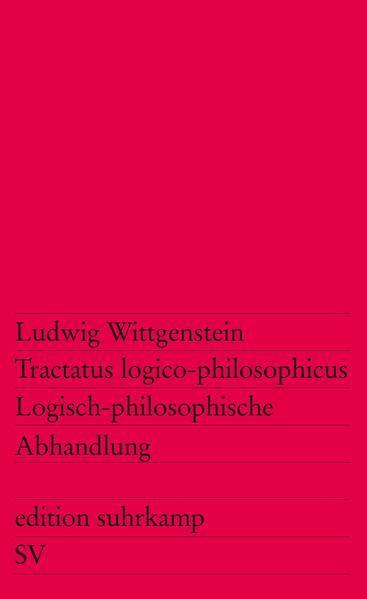German language
Published May 7, 1963 by Suhrkamp Verlag.

German language
Published May 7, 1963 by Suhrkamp Verlag.
The Tractatus Logico-Philosophicus (widely abbreviated and cited as TLP) is the only book-length philosophical work by the Austrian philosopher Ludwig Wittgenstein that was published during his lifetime. The project had a broad goal: to identify the relationship between language and reality and to define the limits of science. Wittgenstein wrote the notes for the Tractatus while he was a soldier during World War I and completed it during a military leave in the summer of 1918. It was originally published in German in 1921 as Logisch-Philosophische Abhandlung (Logical-Philosophical Treatise). In 1922 it was published together with an English translation and a Latin title, which was suggested by G. E. Moore as homage to Baruch Spinoza's Tractatus Theologico-Politicus (1670). The Tractatus is written in an austere and succinct literary style, containing almost no arguments as such, but consists of altogether 525 declarative statements, which are hierarchically numbered. The Tractatus is recognized …
The Tractatus Logico-Philosophicus (widely abbreviated and cited as TLP) is the only book-length philosophical work by the Austrian philosopher Ludwig Wittgenstein that was published during his lifetime. The project had a broad goal: to identify the relationship between language and reality and to define the limits of science. Wittgenstein wrote the notes for the Tractatus while he was a soldier during World War I and completed it during a military leave in the summer of 1918. It was originally published in German in 1921 as Logisch-Philosophische Abhandlung (Logical-Philosophical Treatise). In 1922 it was published together with an English translation and a Latin title, which was suggested by G. E. Moore as homage to Baruch Spinoza's Tractatus Theologico-Politicus (1670). The Tractatus is written in an austere and succinct literary style, containing almost no arguments as such, but consists of altogether 525 declarative statements, which are hierarchically numbered. The Tractatus is recognized by philosophers as one of the most significant philosophical works of the twentieth century and was influential chiefly amongst the logical positivist philosophers of the Vienna Circle, such as Rudolf Carnap and Friedrich Waismann and Bertrand Russell's article "The Philosophy of Logical Atomism". Wittgenstein's later works, notably the posthumously published Philosophical Investigations, criticised many of his ideas in the Tractatus. There are, however, elements to see a common thread in Wittgenstein's thinking, in spite of those criticisms of the Tractatus in later writings. Indeed, the legendary contrast between ‘early’ and ‘late’ Wittgenstein has been countered by such scholars as Pears (1987) and Hilmy (1987). For example, a relevant, yet neglected aspect of continuity in Wittgenstein’s central issues concerns ‘meaning’ as ‘use’. Connecting his early and later writings on ‘meaning as use’ is his appeal to direct consequences of a term or phrase, reflected e.g. in his speaking of language as a ‘calculus’. These passages are rather crucial to Wittgenstein’s view of ‘meaning as use’, though they have been widely neglected in scholarly literature. The centrality and importance of these passages are corroborated and augmented by renewed examination of Wittgenstein’s Nachlaß, as is done in "From Tractatus to Later Writings and Back - New Implications from the Nachlass" (de Queiroz 2023).